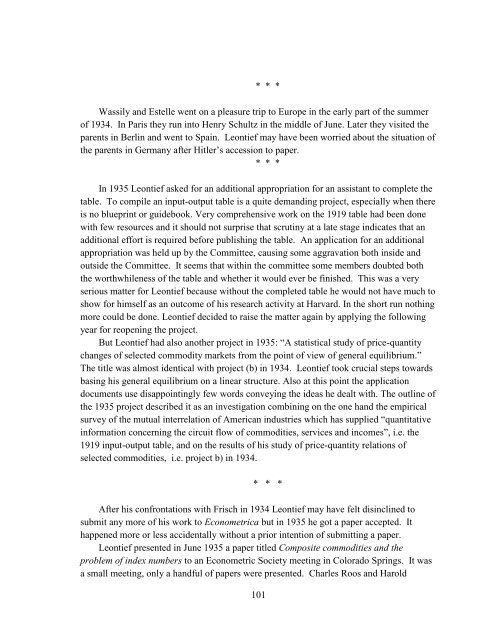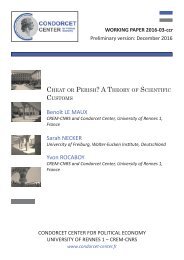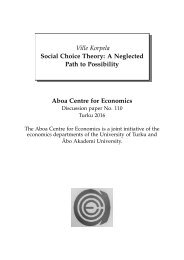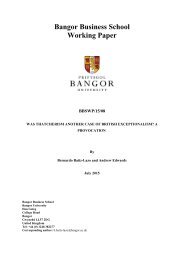MEMORANDUM
n?u=RePEc:hhs:osloec:2016_018&r=hpe
n?u=RePEc:hhs:osloec:2016_018&r=hpe
Create successful ePaper yourself
Turn your PDF publications into a flip-book with our unique Google optimized e-Paper software.
* * *<br />
Wassily and Estelle went on a pleasure trip to Europe in the early part of the summer<br />
of 1934. In Paris they run into Henry Schultz in the middle of June. Later they visited the<br />
parents in Berlin and went to Spain. Leontief may have been worried about the situation of<br />
the parents in Germany after Hitler’s accession to paper.<br />
* * *<br />
In 1935 Leontief asked for an additional appropriation for an assistant to complete the<br />
table. To compile an input-output table is a quite demanding project, especially when there<br />
is no blueprint or guidebook. Very comprehensive work on the 1919 table had been done<br />
with few resources and it should not surprise that scrutiny at a late stage indicates that an<br />
additional effort is required before publishing the table. An application for an additional<br />
appropriation was held up by the Committee, causing some aggravation both inside and<br />
outside the Committee. It seems that within the committee some members doubted both<br />
the worthwhileness of the table and whether it would ever be finished. This was a very<br />
serious matter for Leontief because without the completed table he would not have much to<br />
show for himself as an outcome of his research activity at Harvard. In the short run nothing<br />
more could be done. Leontief decided to raise the matter again by applying the following<br />
year for reopening the project.<br />
But Leontief had also another project in 1935: “A statistical study of price-quantity<br />
changes of selected commodity markets from the point of view of general equilibrium.”<br />
The title was almost identical with project (b) in 1934. Leontief took crucial steps towards<br />
basing his general equilibrium on a linear structure. Also at this point the application<br />
documents use disappointingly few words conveying the ideas he dealt with. The outline of<br />
the 1935 project described it as an investigation combining on the one hand the empirical<br />
survey of the mutual interrelation of American industries which has supplied “quantitative<br />
information concerning the circuit flow of commodities, services and incomes”, i.e. the<br />
1919 input-output table, and on the results of his study of price-quantity relations of<br />
selected commodities, i.e. project b) in 1934.<br />
* * *<br />
After his confrontations with Frisch in 1934 Leontief may have felt disinclined to<br />
submit any more of his work to Econometrica but in 1935 he got a paper accepted. It<br />
happened more or less accidentally without a prior intention of submitting a paper.<br />
Leontief presented in June 1935 a paper titled Composite commodities and the<br />
problem of index numbers to an Econometric Society meeting in Colorado Springs. It was<br />
a small meeting, only a handful of papers were presented. Charles Roos and Harold<br />
101





